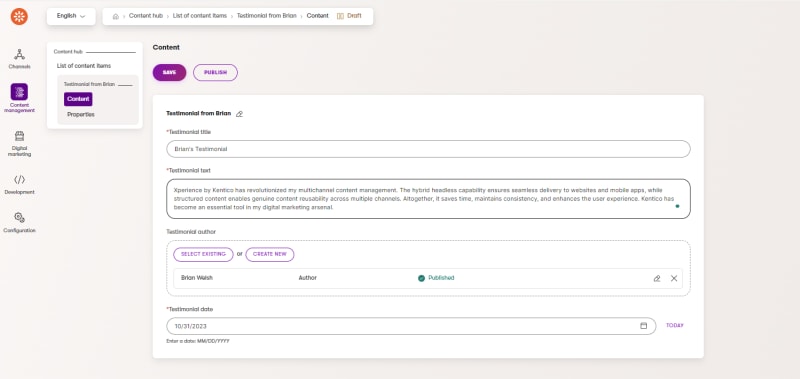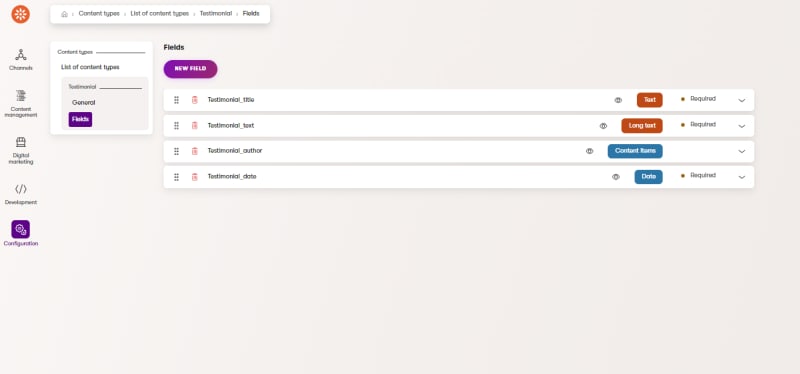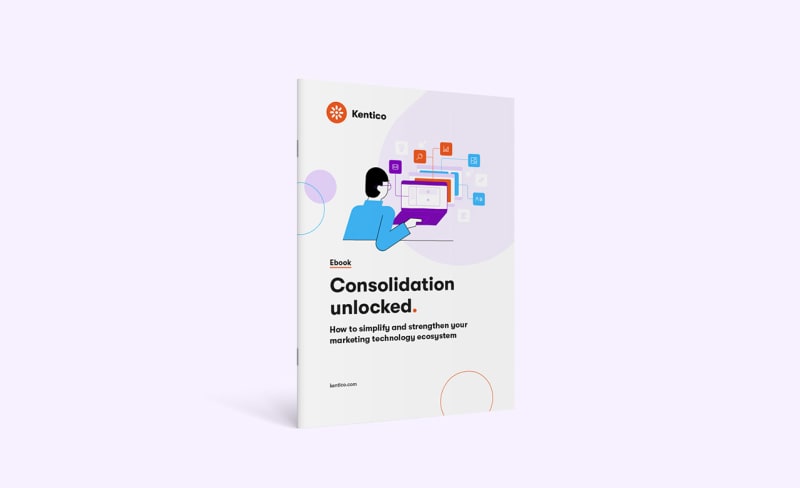The digital marketing landscape is evolving rapidly. According to chiefmartech.com’s Marketing Technology Landscape Supergraphic, 1,106 new marketing tools were launched in the last year alone (2022-2023), resulting in a total of 11,038 MarTech tools on the market. Of these, 329 are in the Content Management & Web Experience Management category.
With so many products to choose from, businesses face difficulties when researching and shortlisting MarTech tools. Additionally, there is a great deal of hype in the air surrounding concepts like headless, multichannel, multiexperience, composability, AI, and many more. All of this together makes the selection of the right tool a real nightmare.
The modern digital marketing agenda expects a multitude of activities supported by a vast array of tools, now including those for managing content and digital experiences across multiple channels. Almost every business uses a variety of marketing tools, including a Content Management Systems (CMS) or Digital Experience Platforms (DXP), a landing page builder, analytics, an emailing tool, social media management tools, and more. As companies grow, so does the number of MarTech tools they employ.
In this article, our focus will be on content management tools and how to achieve orchestration across multiple digital channels. Based on our research* conducted in the summer of 2023, it was found that 31% of companies use three or more CMSs or DXPs to handle content management-related tasks. These systems are either interconnected to achieve content synchronization, or completely isolated, resulting in siloed data. Employing such separated content management systems not only hinders efficient content management, but also leads to increased expenses in terms of maintenance and security.
*Research conducted by Kentico Software in the summer of 2023 on 500 digital marketing executives, in companies of 250+ employees, mainly in USA, UK, and EU.
Complexity is the road to efficiency hell
Many marketing teams purchase and use a variety of marketing tools for content management and digital marketing without a clear strategy. These acquired systems are not well integrated and often come from multiple vendors, making their use, integration, and maintenance a nightmare. Furthermore, these tools may be subject to different pricing models, including pay-as-you-go billing, monthly or annual billing, per-user or tiered pricing, among others. As the demands of marketing teams increase, particularly when handling campaigns across multiple digital channels, the complexity of their toolset tends to grow over time. This complexity results in inefficient marketing teams and wasted investments with no return.
Now, let’s take a closer look at the costs associated with this complexity.
Costs of complexity
Some costs are easy to quantify, while others are difficult to even identify:
- Growing technology stack TCO:
As the number of your MarTech licenses grows, your marketing capital and operating expenditures (CAPEX and OPEX) inevitably expand. These increased costs are not limited to license expenses but also encompass integration and maintenance costs. This, in turn, results in unnecessary overhead that makes OPEX hard to predict. Your Total Cost of Ownership (TCO), therefore, is an ever-moving target. - Complexities and inefficiencies:
If you decide to go with products from multiple vendors, you are asking your marketing and content teams to learn and adopt different product UIs and UX standards, which will inevitably slow them down. You will also have more vendors to deal with during the evaluation and procurement process, implementation, integration, maintenance, and troubleshooting. - Greater content management effort:
Using multiple content management tools to enable communication across multiple digital channels will be a struggle for your marketing team, who need to create, distribute, and maintain content in multiple tools and ensure it is consistent and up to date. You may even have to hire additional specialists to manage such tools. - Duplication and inconsistencies:
Managing content in multiple tools to ensure multichannel communication inevitably leads to duplicate content in multiple locations. During the content creation phase, you may need to copy and paste content in order to reuse it across multiple channels. This then makes it nearly impossible to keep up to date and ensure consistency in your message across all locations. Inconsistent and outdated product specifications, differing messaging, and varying success proof numbers can confuse and erode the trust of customers.
These are just some examples of how the complexity resulting from using multiple CMS, DXP, and other digital experience tools inflates expenses and returns suboptimal ROI.
At Kentico, we believe that the solution to enhancing the efficiency of marketing teams lies in consolidating these core multichannel content and experience management tools.
Consolidation as an escape from complexity
Consolidation in the use of software tools refers to the practice of streamlining and centralizing the various software applications and tools used within an organization. It involves reducing redundancy and eliminating unnecessary software, often in favor of more integrated and efficient solutions.
At Kentico, we believe that consolidating multichannel content management and digital experience management tools in a single-vendor product will enable you to regain better control over the digital experience you provide. Not only will you be able to manage content distributed across multiple digital channels from one environment, but you will also be able to track, personalize, and optimize it for better performance. In practice, this means fewer tools to learn and work with, fewer tools to pay for, and fewer tools to integrate and maintain. This, in turn, results in the ability to bring products to market faster with fewer resources.
In general, the consolidation of your software stack leads to the following benefits:
- Cost reduction: By eliminating redundant software licenses, maintenance costs, and support expenses, organizations can reduce their overall software expenditure.
- Better efficiency: Consolidation of software tools can improve workflow efficiency. Users don't need to switch between multiple applications and data can flow more smoothly between different systems.
- Simplicity: Fewer software tools mean simpler management and training processes for IT teams and end-users Additionally, opting for a single-vendor solution for your content management and digital experience means having only one subscription plan, one support team to communicate with, and one solution to maintain. All of these factors also lead to reduced cost .
- Data integration: Consolidation often involves integrating data and processes across different departments and functions, which can lead to better data analysis and decision-making.
- Standardization: Standardizing a particular set of tools can improve consistency and reduce compatibility issues. Your teams won’t need to deal with multiple UI, UX, and code standards.
- Security: Fewer software tools can lead to a reduced attack surface as there are fewer potential vulnerabilities to exploit.
- Compliance: In regulated industries, consolidation can help ensure that all software used meets regulatory compliance standards.
So, you can see that consolidating a myriad of tools into one digital experience platform brings multiple layers of efficiency, security, simplicity, and cost savings. The type of DXP you choose will also determine how well you can manage the digital experiences you are aiming to deliver. At Kentico, we believe in the hybrid-headless approach, which means our solution offers headless capabilities (where the front and back ends are decoupled) as a feature that you can choose to apply to specific use cases rather than having to apply a headless approach to the entire solution which can significantly impact on marketing efficiency.
Consolidation of your CMSs, DXPs and digital marketing tools into a single-vendor hybrid headless DXP will help you to achieve the following efficiency drivers:
- Multichannel content delivery: Content can be delivered to a wide range of channels (such as websites, email, web and mobile applications, wearables, kiosks, IoT devices, social media, and more) thanks to headless APIs that allow the seamless integration and bilateral exchange of data with third-party tools. As new channels emerge, content can be quickly adapted and distributed without major redevelopment.
- Content reusability across channels: To achieve content reusability, you need a central content repository – a content hub in which content can be stored in a structured format, making it easy to reuse across various platforms and channels. Modular content fragments (content items) can be used or reused in multiple contexts, reducing duplication of effort and ensuring consistent messaging.
- Faster content updates: Changes to content can be made centrally and immediately propagated to all connected platforms and devices. This eliminates the need to update content separately on each individual channel, saving time and reducing the risk of errors.
Xperience by Kentico brings everything together
Xperience by Kentico provides a wide set of digital marketing tools, such as email marketing, personalization, and contact management (including multichannel content management) in a single-vendor platform. It offers a modern and consistent UI and UX for easy content management across multiple digital channels.
Multichannel management under one roof
Even though we hear about headless CMS everywhere, the website remains the primary digital channel for most of our clients. That's why Xperience by Kentico is a hybrid headless DXP. You can quickly and conveniently manage content with a web-centric approach for efficient website content management. Plus, its headless capability allows you to manage content across digital channels where the front-end presentation is decoupled from the DXP back end. This provides the best of both worlds: convenient content management with seamless multichannel capabilities.
To speed up your marketing teams, Xperience by Kentico offers convenient drag-and-drop visual page builders, widgets, templates, and all the tools you're accustomed to from traditional CMS or DXP products. It also provides ready-to-use email marketing capabilities to support your email marketing campaigns, send regular newsletters, and provide out-of-the-box autoresponders.
Structured content enables cross-channel content reusability
Xperience by Kentico employs a structured content approach, enabling you to create small content fragments (Content items) and use them as building blocks for web pages, emails, or for managing content in your mobile and web applications. The Content items can be organized to satisfy your business needs. For example, they can be organized to the following Content types: Product Details, Featured Content, References or Testimonials, Benefits, Calls to Action (CTA), Articles, Images, Banners, or any other types suitable for reuse across websites, emails, or other digital channels.

Image: Example of a testimonial Content item
Let’s take the example of a testimonial. It’s common for a testimonial to be reused across different pages on websites, in email campaigns, on mobile apps, etc. “Testimonial” is a Content type, while “Brian’s Testimonial” is a specific Content item. This item has been built from other Content items such as Title, Text, Author, and Date. Some of the Content items (in this case Author), can be built from other Content items such as Name, Company, Job title. This way, you can design a structure for any Content type that’s already in an ideal shape for reuse.

Image: Example of Content item fields
Structured content allows content to be published across any channel or to any device from a familiar user interface. This efficiency enables you to create content pieces once and reuse them across various channels to generate diverse digital experiences. This not only saves on content production resources but also prevents Content items from being stored in multiple content management systems, thus avoiding duplication and messaging inconsistencies. This approach enhances the productivity of your marketing teams, enabling them to achieve more with fewer resources.
Become future proof, now
Streamlining your marketing ecosystem should be your next strategic move. The complexity of the modern marketer’s work is growing, with new marketing disciplines emerging, along with an increasing number of digital marketing channels. Handling the numerous tasks digital marketers face today is challenging, and preparing for the unpredictable future, even more so. Digital marketers need future-proof solutions.
Managing more marketing channels from a highly flexible, single-vendor platform can enhance productivity today and prepare you for the streamlining of your digital marketing initiatives in the future.
Get more tips about simplifying complexity with our free ebook, Consolidation unlocked. Download to learn more!


